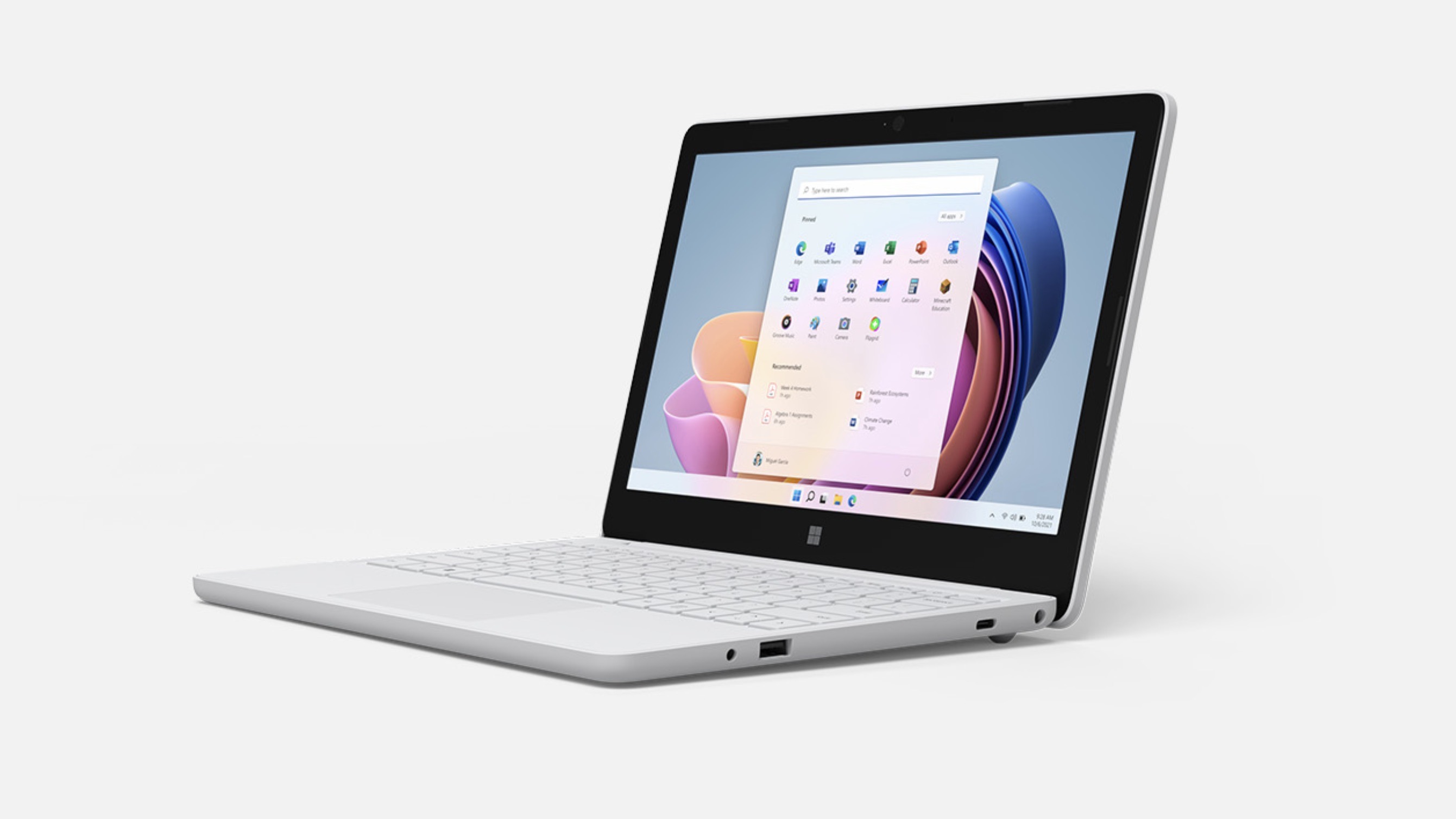Microsoft’s Surface Laptop SE is a turning point for right to repair
The right to repair movement is moving from the fringes to the mainstream, but everyone needs to step up

In January, Microsoft released a video featuring Brandon Cole, a senior DFX engineer at Microsoft’s Design for Repair. In a little over seven minutes, Brandon whips apart the new Surface SE laptop, which is a low-powered, budget-conscious unit designed for the education sector. Its USP is that a parts and spares infrastructure is also on-stream, so schools can fix broken laptops themselves.
The current trend is that broken PCs and tablets are shoved in a cupboard because mainstream schools simply don’t have the budget to replace the unrepairable. The introduction of this device may be the point that history recalls as the moment big tech took the right to repair (R2R) seriously.
I threw my proverbial toys out of the pram largely because of the rhetoric crowbarred into Brandon’s script. At 3:41, he says: “There’s a lot of work that went into designing this device to be so repairable.” I believe what the scriptwriter possibly meant to say was: “We found a five-year-old HP Stream in a bin and ran it through the photocopier.” There is nothing about the Surface SE that hits a progressive definition of repairable. All the usual suspects that I bang on about, like soldered on RAM and eMMCs, are here. The best we can say is that the Surface SE has replaceable and available parts, which is an underwhelming statement for such a seismic shift in the correct direction.
Brandon amplified my annoyance by proclaiming alternative names for parts of a laptop, C-covers and D-Buckets, before showboating about the Surface SE’s need for “only” two different screwdriver bits to get it apart. At the same time, Microsoft released service manuals for six devices in the Surface range that spell out exactly how unrepairable these things are.
So, if anyone from Microsoft is reading, this is for you. The world-wide repair communities already have nomenclature, so you don’t need to focus-group new names for stuff that already exists. Also, producing videos that suggest you’re all-in with repairability whilst simultaneously releasing documentation proving it’s an alien concept smacks of greenwashing. Stop it!
Applying shareholder pressure
Microsoft, Apple and Google have all recently made public declarations about repair. In February, Google announced a repair-scheme for education similar to Microsoft’s, and although it would be nice to report a triggering of collective corporate conscience, it’s more likely down to the persistence of clever activists.
RELATED RESOURCE

The challenge of securing the remote working employee
The IT Pro Guide to Sase and successful digital transformation
As You Sow is a shareholder advocacy group that effectively buys into a corporation, using that foothold to leverage change from within. In June 2021, it filed a shareholder resolution to Microsoft’s board instructing them to analyse “environmental and social benefits” of “making device repair easier”. In November 2021, Green Century Funds, another shareholder advocacy group, repeated the trick with Apple and then did the double in January 2022 with Google’s parent company, Alphabet. Although it’s too early to say how Google will react, both Microsoft and Apple trumpeted plans to improve repairability for consumers and independent repair shops in exchange for the resolutions to be withdrawn.
Sign up today and you will receive a free copy of our Future Focus 2025 report - the leading guidance on AI, cybersecurity and other IT challenges as per 700+ senior executives
Various legislative changes are also tightening the marketplace and making it more difficult to sell products that are deemed to be unrepairable. The EU is building on its own e-waste measures and planning to introduce legislation that increases the statutory warranty periods of many devices. Australia passed R2R for the motor industry, creating a law that makes it illegal for car manufacturers to withhold information from qualified independent mechanics.
Fairphone 4 Review: A modular phone for a wasteful world
Meanwhile, in the US, President Biden included support for R2R in an executive order. America has state-wide pockets of legislation that put repair options back into the hands of consumers. Activists earned a significant victory last year regarding telematics, which is an umbrella term for vehicle data-collection systems, built into modern cars and trucks. They include GPS, vehicle diagnostic systems and many proprietary “black box” technologies that transmit data to various agencies including manufacturers, law enforcement and insurers. Anti-repair lobbyists have often protested that telematics are integral to vehicle functionality but, when their use was banned in Massachusetts, Subaru voluntarily turned off the Starlink telematics system in vehicles sold in 2022.
What is encouraging, particularly from Microsoft, is the tech companies’ engagement with repair-tool specialists, iFixit. One of the major challenges with repairing a Surface is disassembling the screen. iFixit has created the Surface Display Debonding Tool to make the job easier. With suitable tools and specifically one designed for repair, keeping technology alive becomes much simpler. Thanks to companies like iFixit and ReplaceBase, tools are readily available to everyone at a cheap price. A basic set of drivers, spudgers and picks to get into the iPhone cost less than £2 and the replacement battery was under £6.
Overcoming the e-waste mountain
This should be a big year for the R2R movement, but it’s important to remember it’s one tiny component of the circular economy model that controls the entire production process from resource gathering to post-disposal emissions monitoring. The UK Parliament’s own Environmental Audit Committee urged the government to appreciate the seriousness of global e-waste. Ministers read it and subsequently turned a blind eye to water companies filling rivers with sewerage and microplastics. There is a genuine desire for the UK to get serious about homeland battery production in an era of electrification, but I’ve yet to see any proposal that seriously considers battery disposal and recycling.
The UK’s ability to dispose of e-waste is shameful, as we’re the second highest producer in the world. Businesses can certainly do more across the country, as can local authorities. When I take a battery down to my local council recycling centre, for example, there’s an almost 100% chance it’ll be either crushed, burnt, crushed and burnt or sold overseas, where it’ll end up in places like Agbogbloshie in Ghana.
A circular economy dictates that a battery should be stripped and any rare earth elements retrieved, and the plastics or metals identified and salvaged. Whatever’s left – and there shouldn’t be much – can then be processed as end of life in a way that doesn’t damage the environment. A BBC report from 2021 estimated that globally, only 5% of lithium-ion batteries are recycled. There is much work to be done in this sector, but R2R can help here too.
RELATED RESOURCE

There is serious money to be made in R2R as the repair economy is currently tiny. There are opportunities for employment in repairs and diagnostics on a scale far bigger than we currently have. For this to be viable, there needs to be access to information about the parts and components used inside our devices, so manufacturers need to open the filing cabinet. With a decent after-parts market, reliable, decent quality, refurbished machines become a genuinely attractive alternative for all of us, removing the “will it last” gamble that many consumers fear.
Manufacturers spend fortunes trying to find the trigger that makes us throw cash at them and Steam has realised that the trigger could be repairability. In February, the gaming giant announced that iFixit will be one of the authorised sellers of Steam Deck replacement parts. Dell’s Concept Luna, meanwhile, which was showcased at CES 2022, ditches synthetics to manufacture PCBs from flax-fibre bonded with a water soluble polymer. The concept also extends to being able to repurpose unwanted high-end components and motherboards in “new” low-end laptops. This is proof that product designers can wow us with repairable innovations if their management allows, and serves as justification that shareholder advocates injecting pressure into the boardroom is a fabulous strategy.
Lee’s career began in TV as a programme maker for the BBC, ITV and Channel 4, specialising in education, history and science. He was part of the early video-on-demand team for ITV which lead to technical roles within the fledgling online-shopping department for ASDA/Walmart.
In 2003, he and his wife escaped the corporate world and setup a computer repair business focussing on the consumer side of the market.
Lee is a contributing editor and podcaster for sister title PC Pro with a particular interest in the right-to-repair movement and the circular economy. He can usually be found running around the streets of Yorkshire at a ridiculous time of the morning, and he’s also trying to solve a mystery involving David Bowie.
You can reach Lee at lee@inspirationcomputers.com or @tnargeel
-
 Trump's AI executive order could leave US in a 'regulatory vacuum'
Trump's AI executive order could leave US in a 'regulatory vacuum'News Citing a "patchwork of 50 different regulatory regimes" and "ideological bias", President Trump wants rules to be set at a federal level
-
 TPUs: Google's home advantage
TPUs: Google's home advantageITPro Podcast How does TPU v7 stack up against Nvidia's latest chips – and can Google scale AI using only its own supply?

